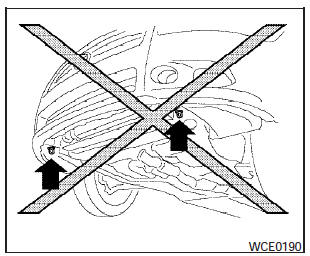Vehicle recovery (freeing a stuck vehicle)

Pulling a stuck vehicle
Do not use the hook (if so equipped) to tow the vehicle.
WARNING:
- Stand clear of a stuck vehicle.
- Do not spin your tires at high speed.
This could cause them to explode and result in serious injury. Parts of your vehicle could also overheat and be damaged.
CAUTION:
- Tow chains or cables must be attached only to the main structural members of the vehicle. Otherwise, the vehicle body will be damaged.
- Do not use the vehicle tie downs to free a vehicle stuck in sand, snow, mud, etc.
Never tow the vehicle using the vehicle tie downs or recovery hooks.
- Always pull the cable straight out from the front or rear of the vehicle. Never pull the vehicle at an angle.
- Pulling devices should be routed so they do not touch any part of the suspension, steering, brake or cooling systems.
- Pulling devices such as ropes or canvas straps are not recommended for use in vehicle towing or recovery.
Rocking a stuck vehicle
If your vehicle is stuck in sand, snow, mud, etc., use the following procedure:
1. Turn off the Vehicle Dynamic Control System.
2. Make sure the area in front and behind the vehicle is clear of obstructions.
3. Turn the steering wheel right and left to clear an area around the front tires.
4. Slowly rock the vehicle forward and backward.
- Shift back and forth between R (Reverse) and D (Drive).
- Apply the accelerator as little as possible to maintain the rocking motion.
- Release the accelerator pedal before shifting between R (Reverse) and D (Drive).
- Do not spin the tires above 35 mph (55 km/h).
5. If the vehicle cannot be freed after a few tries, contact a professional towing service to remove the vehicle.
See also:
Lift gate
- Always be sure the lift gate has
been closed securely to prevent it
from opening while driving.
- Do not drive with the lift gate open.
This could allow dangerous exhaust
gases to be dra ...
If your vehicle overheats
If your vehicle is overheating (indicated by an
extremely high temperature gauge reading), or if
you feel a lack of engine power, detect abnormal
noise, etc., take the following steps.
WARNING
&# ...
EXTERIOR
The Juke's front styling is supposed to evoke thoughts of a crocodile sitting
just below the surface of the water, with its eyes peeking out, according to
Nissan. My neighbor's kindergarten-age so ...
